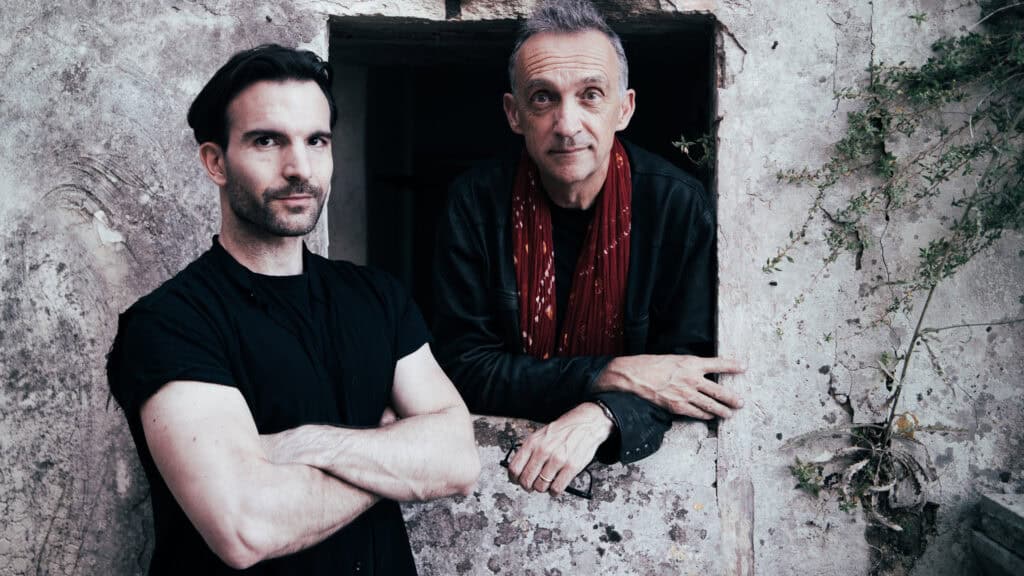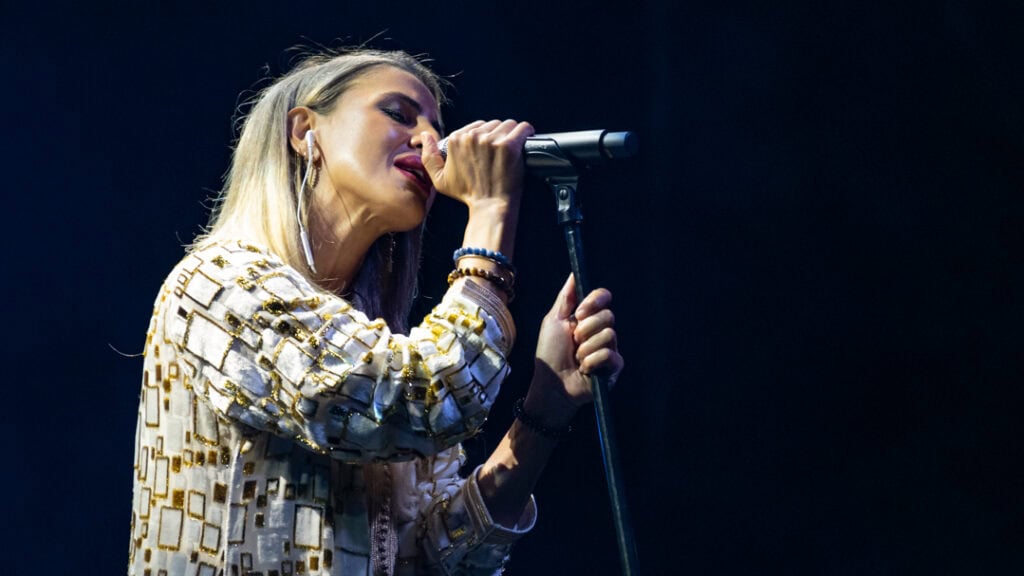
Il 17 luglio il Teatro Romano di Fiesole ha ospitato l’unica data europea di Dana Al Fardan, prima donna compositrice contemporanea e cantautrice a emergere nei paesi del Golfo, nota per la sua rivoluzionaria ed eclettica fusione di musica classica contemporanea araba e occidentale. Abbiamo incontrato Dana durante le prove, mentre visionava lo spettacolo di danza che avrebbe accompagnato lo show.
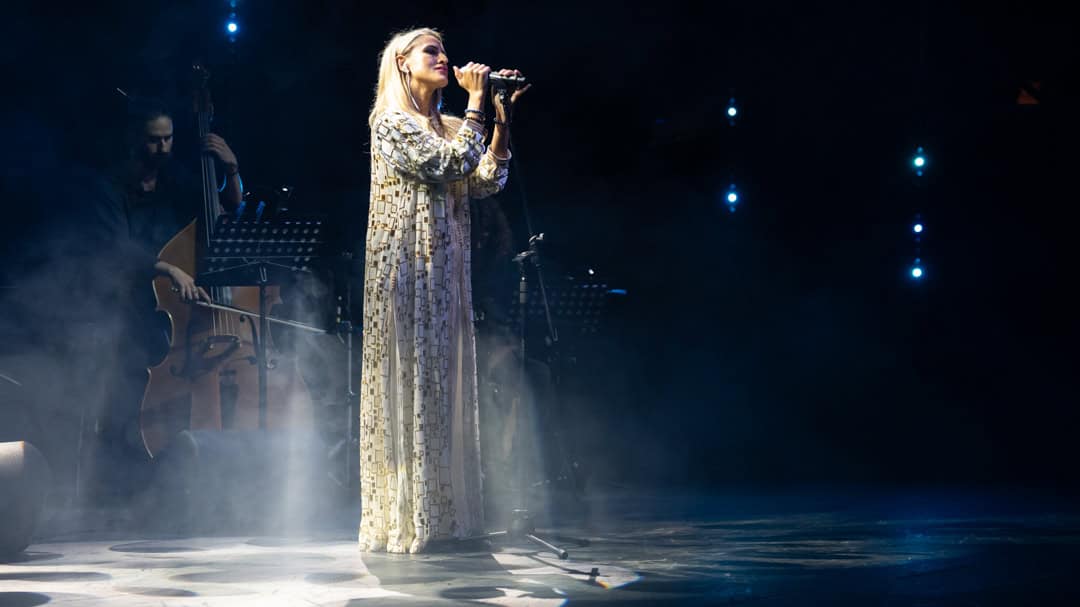
Siamo molto orgogliosi che il tuo unico concerto del 2024 in Europa sia qui, a Firenze. È stato un caso?Beh, in realtà no, niente è casuale. Il mio viaggio nello spettacolo “Indigo” è tutto incentrato sul manifestarsi, manifestare il proprio viaggio verso il sé superiore. Un percorso che riflette la propria essenza, il sé superiore, ciò che è in sintonia con il personale ritmo naturale. Il mio precedente concerto in Europa è stato a Cannes durante il Festival del Cinema, ma non era un concerto pubblico, era per il Trofeo Chopard. Ma a settembre 2023 sono stata a Firenze e ho fatto un spettacolo privato per Emilio Cavallini all’inaugurazione della sua mostra alle Serre Torrigiani, dove ho fatto una piccola configurazione del mio “Indigo”. L’arte di Emilio Cavallini era tutta incentrata sul colore e anche il mio lavoro è incentrato sul colore, “Indigo” è un viaggio verso uno stato di coscienza superiore, e ogni canzone ha un paesaggio sonoro e una combinazione di colori pensati per innalzare la frequenza vibrazionale; si basa sulla teoria del colore di Goethe, sulle qualità emotive del colore. Quindi, scelgo un colore per ogni canzone per indurre quello stato emotivo che permette di andare consecutivamente verso uno stato più elevato della coscienza e di innalzare la frequenza vibrazionale. Perché quando la nostra frequenza è in movimento, attiriamo naturalmente ciò che è destinato a noi.
Quando ero a Firenze, ho girato come turista, e ho visitato Fiesole per guardare il bellissimo anfiteatro romano, ho un legame molto forte con le terre antiche. Ero seduta lì, percependo l’energia del luogo, come se fosse già successo qualcosa di personale. L’eccitazione e la tensione si sentivano, e io stavo già manifestando un concerto lì dentro. Così ne ho parlato con il mio manager, Adelchi Virgili; lui ha chiamato il direttore artistico dell’Estate Fiesolana, Claudio Bertini, gli ha mandato il mio profilo e 10 giorni dopo hanno risposto che erano interessati. Letteralmente, è successo così. Ma questo è il viaggio di “Indigo”, questa è la storia. Sapete, la storia è che tutto ciò che è destinato a voi accadrà, ed è solo uno stato di abbandono. Quindi, siamo qui perché avevo adottato la frequenza che attirava tutto ciò che era destinato a me. Inoltre, mi stavo connettendo con le radici di questa terra. Quando ci si connette con le radici di qualcosa, si ha sempre una relazione duratura. Non importa se con una persona, con un luogo o con una pietra. Sì, quando ci si connette alle radici, all’essenza, sarà un rapporto che si avrà per il resto della vita. Questo porterà a qualcosa, sai, e questo è il modo in cui vivo la mia vita e ciò in cui credo. È questo che mi ha portato qui ed è così che ho iniziato la mia carriera musicale.
Raccontami la tua storia …
Lavoravo per l’azienda di famiglia che si occupava di vendita al dettaglio di gioielli, di immobili e di ospitalità. Mi occupavo principalmente di gioielli, quindi la mia formazione è in realtà in scienze politiche e gemmologia. Quindi, la teoria delle pietre preziose e la teoria della luce sono molto presenti nel mio lavoro. Perché noi siamo come pietre. Siamo esseri organici… Ogni gemma ha un significato, ha una frequenza e una qualità energetica. E ha una vibrazione che si può percepire, forse positiva, ma anche negativa allo stesso tempo. Come le persone.
Mia figlia qualche mese fa mi ha detto: “ Voglio buttare via questa gemma – le era stata regalata – perché mi fa star male …”.
Sì, ha ragione. Anche se si trattava di un bellissimo gioiello. Potrebbe essere una sensazione molto pesante, perché la malattia nasce dalla perdita di allineamento. E questo è il punto centrale dell’album “Indigo”. Dovrebbe essere uno spazio che genera un allineamento al vostro centro. Aiuta a sbloccare i chakra attraverso le onde sonore, attraverso le frequenze sonore. Come stavo descrivendo l’altro giorno, avete mai usato una macchina per massaggi? Quando c’è un blocco nel muscolo, si applica una vibrazione. È così che il suono lavora con il nostro corpo.
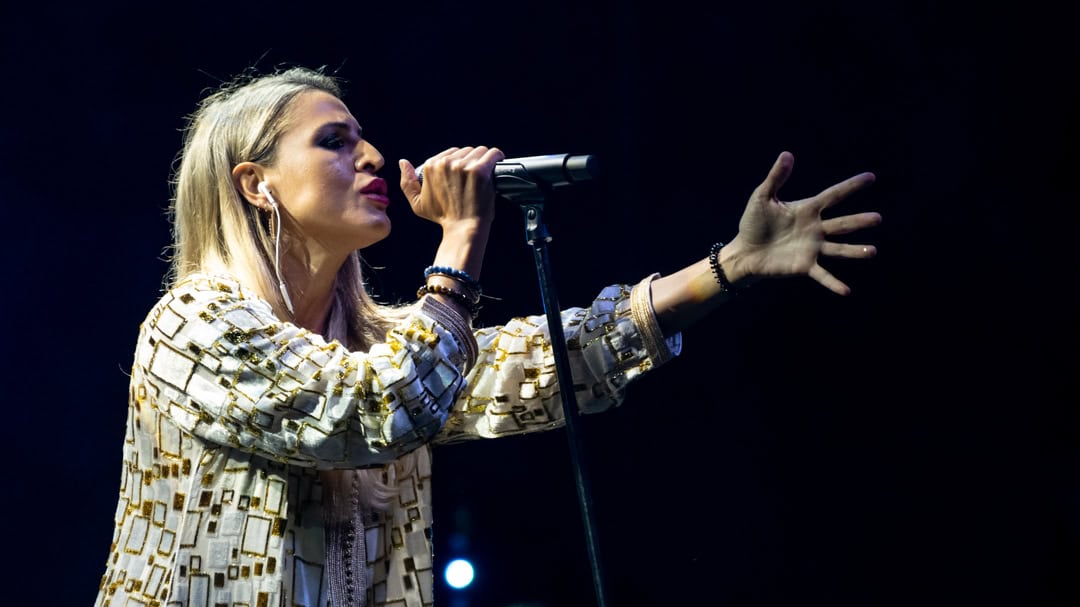
Suonerai tutto l’album qui a Fiesole?
Suonerò tutto l’album a eccezione di un pezzo, “Harlequin”, solo perché quel pezzo ha bisogno di uno strumento arabo che può essere suonato solo da un musicista che non è potuto venire qui. Senza quello strumento, non avrebbe senso. Potremmo mandarlo in playback, ma suonerebbe falso e strano. Tornando alle gemme, impostiamo l’intenzione di massimizzare l’assorbimento e la trasmissione della luce. In una gemma, in un diamante, sappiamo che il tagliatore estrae la pietra per vedere qual è la gemma migliore che può creare, per massimizzare la trasmissione e l’assorbimento. Così la pietra assorbe e trasmette la luce senza sforzo. Questo è ciò che vogliamo. Vogliamo assorbire e trasmettere la luce senza sforzo. È questo che muove tutto ciò che ci circonda. Suoneremo tutte le altre canzoni dell’album, ma il modo in cui le eseguiamo non corrisponde all’ordine di “Indigo”, inizio con il canto, mentre nell’album la voce arriva alla fine. Poiché stiamo definendo l’intenzione, la prima canzone è “Crystalline”, e diciamo che vogliamo massimizzare l’assorbimento e la trasmissione della luce. La seconda canzone è “Chromium”. Il cromo è rosso, è ritmo pulsante e martellante. È ciò che ci fa andare avanti. E il cromo è l’oligoelemento che entra in una pietra chiamata corindone, che crea il rubino e lo zaffiro. Qual è l’elemento che trasforma l’intera pietra in un rubino? Il cromo. Che cosa capiamo da questo? Il potere dell’individuo di avere un impatto sul proprio ambiente, o anche di una sola persona. È un piccolo oligoelemento, entra in quella pietra e genera un paesaggio completamente diverso. Crea il rubino. Quindi, immaginate di potenziare voi stessi, di comprendere l’impatto che avete sull’ambiente che vi circonda come individui.
La terza canzone è “Spectrum”. Sappiamo che dobbiamo assorbire l’intero spettro dentro di noi per aprirci alla luce. Poiché l’occhio umano non assorbe il 99% dello spettro della luce bianca, il nostro compito è quello di massimizzare l’assorbimento, identificare e riconoscere tutti i diversi componenti che costituiscono l’insieme. È questo che ci permette di avere un’interazione multispettrale con il mondo che ci circonda. Non è per tutti, è necessario ascoltare con il cuore aperto per sentire veramente il messaggio. Perché se si viene qui solo per lo spettacolo, o per i colori, o per la musica, non funziona. È necessario che il tutto sia un’esperienza più che un concerto. Ho sempre visto che la cosa meravigliosa è che una volta che la gente ascolta, la assorbe, e dopo le persone mi dicono: Oh, sai, sento di dover cancellare la riunione di domani perché non credo che sia…. Capita. Ma le persone vengono perché scelgono di farlo inconsciamente. Le persone scelgono sempre qualcosa inconsciamente. Non sappiamo perché, ma hanno scelto inconsciamente questo per qualsiasi motivo. Non molti avrebbero sentito parlare di me. Ok, abbiamo fatto una piccola campagna promozionale, ma chi saprebbe di me? Tutto accade per un motivo.
Chi è questa donna? Andiamo. Andiamo a vedere. Oh, cosa sta succedendo qui? Vediamo cosa succede in questo anfiteatro. Tutto però ha una ragione. Pensate a quando i romani erano qui a guardare gli spettacoli, penso che avessero scelto questo posto per un motivo. Quello che trovo assolutamente stupefacente, e che ho appreso quando sono arrivata qui, è che queste erano rovine etrusche, e che i Romani assediarono questo luogo, mentre il loro campo base era dove si trova Firenze. Qui l’acustica è perfetta, incredibile. Sono entrata qui e ho suonato una canzone di “Indigo”, intitolata “Heliodor”, che sembrava fatta apposta per questo posto. “Heliodor” è come il giallo, le radici, è molto tribale.
Ora qualche parola sulle persone che ti accompagnano sul palco, i musicisti e i ballerini.
Sono molto fortunata ad avere l’opportunità di collaborare con la Lyric Dance Company locale, in modo da poter vedere la storia di “Indigo” attraverso la danza, per espandere la storia dell’album. E volevo integrare più artisti italiani possibile, volevo che questa fosse una collaborazione. Tutto ciò che faccio è una collaborazione, non sono io a dettare il mio lavoro. Una collaborazione è condivisione, non è inviare un file, fai questo, fai quello. È così che l’arte fiorisce, ed è questo che mi entusiasma. Non voglio semplicemente rigurgitare qualcosa. Voglio essere, voglio interagire, voglio assorbire. Alberto Canestro, direttore e coreografo della Lyric Dance Company, ha avuto una visione bellissima. Gli ho mandato la musica e se ne è innamorato. Ha un rapporto così emotivo con la musica! Mi ha detto: ti fidi di me? Gli ho risposto: qualsiasi cosa ne venga fuori sarà la tua interpretazione, e per me va bene.
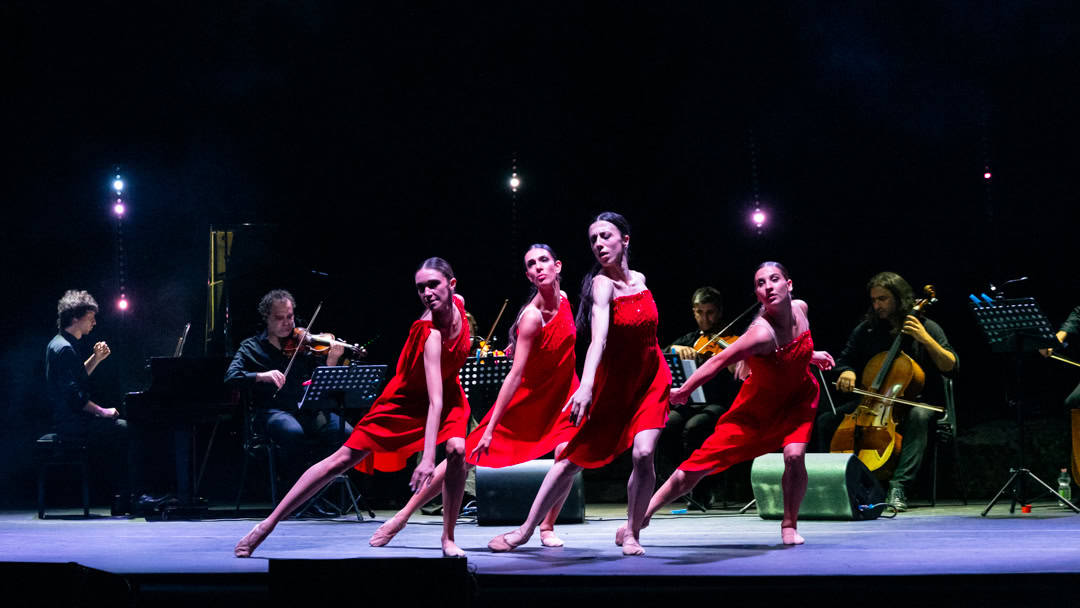
Quindi questa non è solo l’unica data del tuo tour in Europa. È unica perché queste persone sono sul palco con voi per la prima e unica volta…
Chi lo sa? Forse questo sarà un tour. Forse questo è il nuovo “Indigo show”, non lo so. Ed è bellissimo che si unisca a noi l’Orchestra Filharmonie di Firenze. In realtà, ho già collaborato con tre dei musicisti, il pianista, il violoncellista e il secondo violino, a settembre, quando sono stata qui. Mayas Alyamani invece, il primo violino, proviene dalla Qatar Philharmonic Orchestra, ed è l’unico musicista non locale; è venuto con me dal Qatar perché è indispensabile alla mia musica. Di solito viaggio con uno dei membri della mia orchestra, lui o Giovanni Pasini, direttore d’orchestra e anche violista.
Il mio ruolo di ambasciatrice culturale del Qatar è quello di esprimere attraverso il linguaggio universale della musica le nostre intersezioni, le nostre somiglianze e la ricchezza delle nostre differenze. Questa collaborazione ne è l’espressione. Siamo molto diversi, ma è la ricchezza di queste differenze che porta qualcosa di prezioso. Questo è il ruolo della cultura, altrimenti si riempie la scatola di cliché. Questo porta a uno dei maggiori problemi che le etichette discografiche hanno sempre avuto con me. Ecco perché non ho firmato per un’etichetta: non possono classificarmi. Per questo motivo autoproduco i miei album, che si possono trovare su tutte le piattaforme di streaming.
Dana Al Fardan interview
On 17 July, the Roman Theatre in Fiesole hosted the only European date for Dana Al Fardan, the first woman contemporary composer and singer-songwriter to emerge in the Gulf countries, known for her revolutionary and eclectic fusion of Arab and Western contemporary Classical Music. We met Dana during rehearsals, while she was viewing the dance performance that would accompany the show.
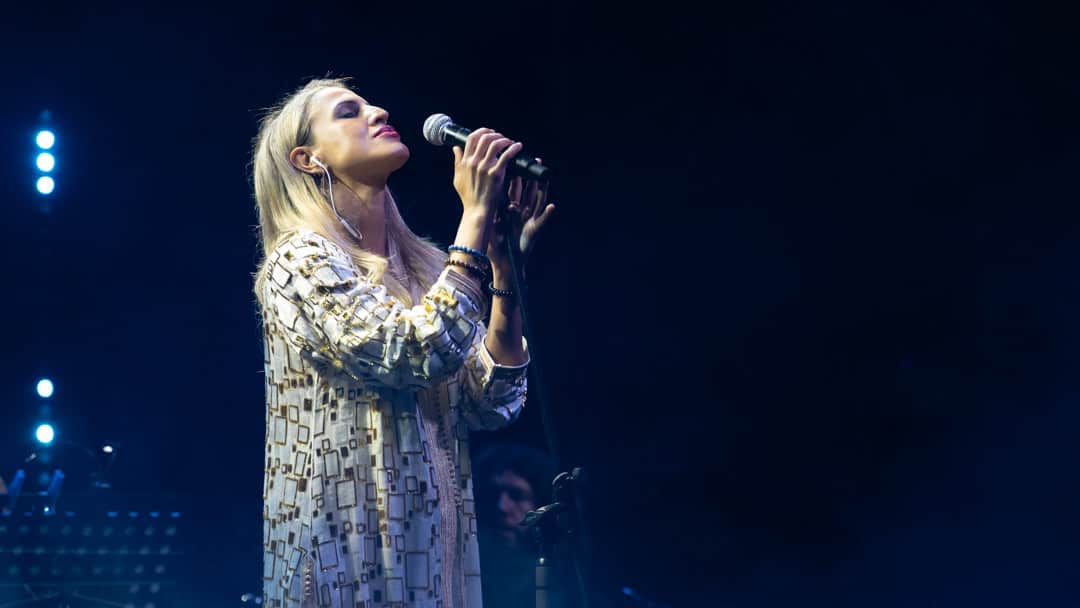
We’re very proud that your only 2024 concert in Europe is here, in Florence. Was a matter of chance?
Well, actually, no, everything happened, nothing is chance. I mean, my “Indigo” show journey is all about manifesting, right? Manifesting your journey towards your higher self. A path that is reflecting of your essence, of your higher self, of what is in tandem with your natural rhythm. So, I’ve been in a state of surrender. My previous concert in Europe was actually in Cannes during the Film Festival, but it wasn’t a public concert, it was for the Chopard Trophy. But I was in Florence in September 2023 and I did a private show for Emilio Cavallini at the opening of his exhibition at Serre Torrigiani, and so I went there and I did a small configuration of my “Indigo”. Emilio Cavallini’s exhibition was all about colour, and my work is about colour as well. “Indigo” is a journey towards a higher state of consciousness, and each song has a soundscape and a colour scheme that’s designed to raise your vibrational frequency; it’s based on Goethe’s theory of color, the emotional qualities of color. So, I choose the color for each song to induce that emotional state that allows you to go consecutively towards a higher state of your consciousness and to raise your vibrational frequency. Because when our frequency is moving, we naturally attract what is meant for us.
When I was in Florence, I went around as a tourist, and visited Fiesole to look at the beautiful Roman amphitheater, and I have a very strong connection to ancient lands. I was sitting there, then I went through the experience, adopting the energy of the place, as if something personal has happened already. Like the excitement, the nervousness, you could see it, you could feel it, and I was manifesting a concert in there. So I talked about it with my manager, Adelchi Virgili; he called up the artistic director of Estate Fiesolana, Claudio Bertini, sent him my profile, and then 10 days later, he came back to say that he was interested. Literally, it happened like that. But that is the “Indigo” journey, that’s the story. You know, the story is everything that’s meant for you to happen, it’s just a state of surrender. So, we’re here because I had adopted the frequency that was attracting everything that was meant for me. And also I was connecting with the roots of this land. Whenever you connect with the roots of something, you always have a lasting relationship. It doesn’t matter whether it’s with a person, with a place, with a stone. Yeah, when you connect to the roots, to the essence, it will always be a relationship that you will have for the rest of your life. That will lead to something, you know, and this is how I live my life and what I believe in. That’s what led me over here, and that’s how I started my music career as well.
Tell me your music story …
I was working for the family business that was in jewelry retail and real estate and hospitality. I was mainly focused on the jewelry side, so my background is actually in political science and gemology. So, hence, the theory of gemstones and light theory features very heavily in my work. Because we’re like stones. We’re organic beings … Every gem has a meaning, it has a frequency and an energetic quality towards it. And it has a vibration that you can feel, maybe positive, but also negative at the same time. Like people.
My daughter told me a few months ago, I want to throw this gem away – she has been given it as a present – because it makes me sick…
Yes, she’s right. Even if it was a beautiful piece of jewelry. It could be a very heavy feeling, because sickness is created by loss of alignment. And this is the whole point about the album “Indigo”. It’s supposed to be a space that generates an alignment to your center. It helps you unblock the chakras through the sound waves, through the sound frequencies. As I was describing it the other day, have you ever used a massage machine? When there’s a block in the muscle, you apply vibration. That’s how sound works with our bodies.
Are you going to play the whole album here in Fiesole?
I’m going to play the whole album with the exception of one piece, “Harlequin”, only because that piece needs an Arabic instrument that can only be played by someone who couldn’t come here. Without that instrument, it wouldn’t have any sense. We could do it in playback, but it would be so weird to hear playback. We have each other song of the album, but the way that we’re performing the songs it is not the order in the album. When we come back to the gemstones, we set the intention to maximize our absorption and our transmission of light. In a gemstone, in a diamond, we know the way that the cutter extracts the stone, he has to see what is the best stone he can create. So the stone is effortlessly absorbing and transmitting light. That’s what we want. We want to be effortlessly absorbing and transmitting light. That’s what moves everything around us. So the set list of the concert is slightly different to the track list of “Indigo”. Always different, because I begin with singing, whereas in the album, the voice comes at the end. Because we’re setting the intention, first song is “Crystalline”, and we say we want to maximize our absorption and transmission of light. Second song is “Chromium”.
Chromium is red. Chromium is the beating, pounding rhythm. It’s what keeps you going. And chromium is the trace element that enters a stone called corundum, which creates ruby and sapphire. What is the one thing that turns that whole stone into a ruby? Chromium. So what do we understand with that? The power of the individual to make an impact in his or her environment. Or one person. It’s one little trace element. It enters that stone, and it generates a completely different landscape. It creates ruby. So it’s like imagine if you empowered yourself, if you actually understood the impact that you make on your surrounding as an individual.
Then the third song, “Spectrum”. Because we know we have to absorb the full spectrum inside of us in order to open ourselves to this full spectrum of light. Because the human eye does not absorb 99% of the white light spectrum, our job is to maximize our absorption, identify and acknowledge all of the different components that makes up the whole. And that’s what allows us to have this multi-spectral interaction with the world around us. It’s not for everyone, you must come here with an open heart to really feel what the message is. Because if you only come here for the show, or for the colours, or for the music, it doesn’t work. You must get everything together as an experience more than a concert. I’ve always seen that what’s so wonderful is once people listen to it, they do absorb it. I hear people coming up to me afterwards that I don’t expect. Not my usual audience, but people that are like Oh, you know, I feel like I need to cancel this meeting tomorrow because I don’t think it’s… You know, it happens. But people come because they choose to unconsciously. People always choose something unconsciously. We don’t know why, but they’ve chosen unconsciously this for whatever reason. Not many would have heard about me. Okay, we did a little promotional campaign, but who would know about me? They probably saw something. They were looking what’s happening and chose it. But everything happens for a reason.
That’s like Who’s this woman? Let’s go. Let’s go see it. Oh, what’s going on over here? Let’s see what’s happening in this amphitheater. Everything is for a reason though. Think about when the Romans were here watching shows. I was thinking they chose this place for a reason. What I find completely astounding, what I learned about when I arrived here, is this were Etruscan ruins, and the Romans laid siege to this place, while their base camp was where Florence is. Here the acoustic is perfect, amazing. I walked in here I played a song from “Indigo”, called “Heliodor”, which seemed made for this place. “Heliodor” is like yellow, it’s roots, it’s very tribal.
Now a few words about the people with you on stage, musicians and dancers.
I’m very blessed to have the opportunity to collaborate with the local Lyric Dance Company, so we can see the story of “Indigo” through dance, to expand the story of the album. And I wanted to integrate more Italian artists, I wanted this to be a collaboration. Everything that I do is a collaboration, it’s not me dictating my work. A collaboration it’s sharing, it’s not sending a file, do this, do that. That’s how art flourishes, and it’s what excites me. I don’t want to just be regurgitating something. I want to be, I want to interact, I want to absorb. Alberto Canestro, the director and choreographer of the Lyric Dance Company, had a beautiful vision. I sent him the music and he fell in love with it. He has such an emotional relationship with the music. He said: do you trust me? I replied: whatever comes out of it’s going to be your interpretation of it, fine with me.
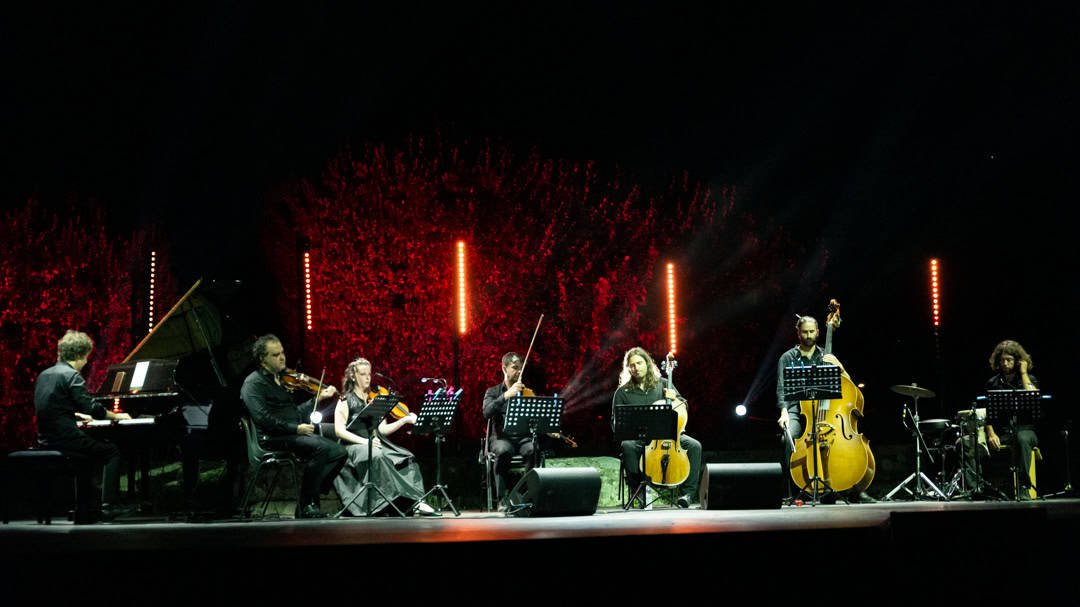
So this is not just the only date of your tour in Europe. It’s unique because these people are on the stage with you for the first and only time…
Who knows? Maybe this is going to be a tour. Maybe this is the new “Indigo show”, I don’t know. And it’s beautiful that we have the Orchestra Filharmonie di Firenze joining us. Actually, I’ve collaborated with three of the musicians when I was here in 2023, the pianist, the cellist and the second violin, in September, when I was here. Mayas Alyamani instead, the first violinist, is from the Qatar Philharmonic Orchestra, and he’s the only musician not local; he came with me from Qatar because he’s so used to my music. I usually travel with one of the members of my orchestra, him or Giovanni Pasini, a conductor and also a viola player.
It’s my role as a cultural ambassador for Qatar to express through the universal language of music; and to express our intersections, our similarities, the richness in our differences. This collaboration is an expression of that. We’re very different, but it’s the richness in these differences that is actually bringing something valuable to everyone. If I cannot give you something different and I sound like everybody else, fine, I just speak to everybody else. There’s no point to deal with you. That’s the role of culture. Otherwise one fills a box of a cliché. This brings to one of the biggest issues that the record labels have always had with me. That’s why I’m not signed with a label: they cannot categorize me. So I self-produce my albums, and you can find them on all the streaming platforms.
Articolo di Francesca Cecconi


